AP Chemistry Kinetics Review Sheet
advertisement
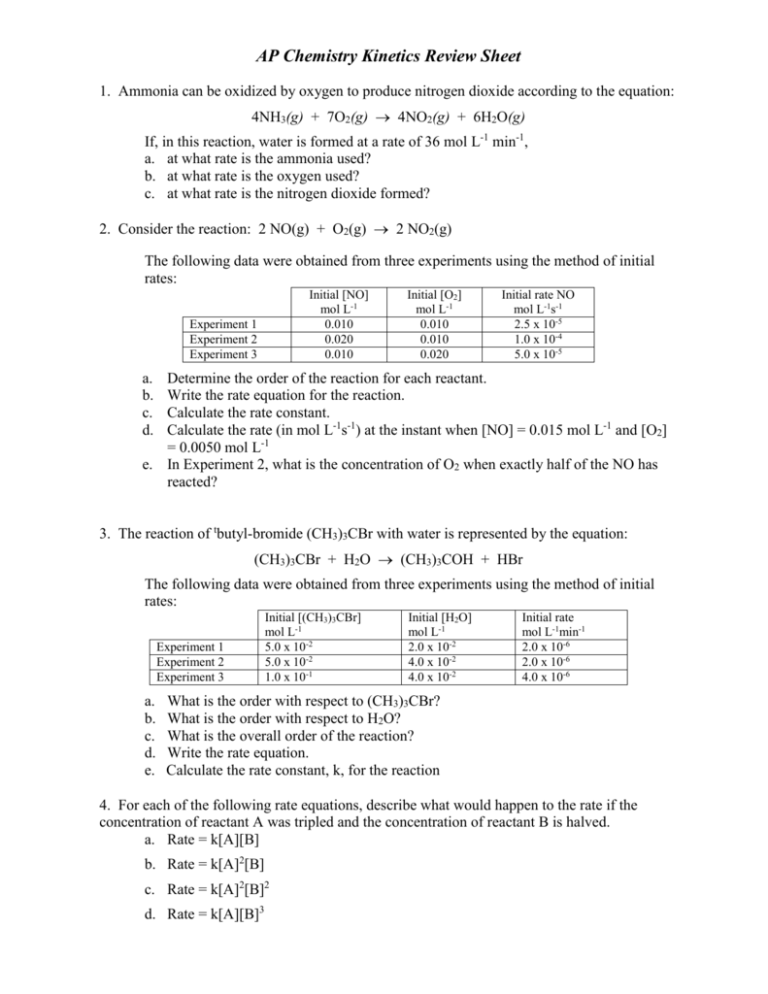
AP Chemistry Kinetics Review Sheet 1. Ammonia can be oxidized by oxygen to produce nitrogen dioxide according to the equation: 4NH3(g) + 7O2(g) 4NO2(g) + 6H2O(g) If, in this reaction, water is formed at a rate of 36 mol L-1 min-1, a. at what rate is the ammonia used? b. at what rate is the oxygen used? c. at what rate is the nitrogen dioxide formed? 2. Consider the reaction: 2 NO(g) + O2(g) 2 NO2(g) The following data were obtained from three experiments using the method of initial rates: Initial [NO] mol L-1 0.010 0.020 0.010 Experiment 1 Experiment 2 Experiment 3 Initial [O2] mol L-1 0.010 0.010 0.020 Initial rate NO mol L-1s-1 2.5 x 10-5 1.0 x 10-4 5.0 x 10-5 a. b. c. d. Determine the order of the reaction for each reactant. Write the rate equation for the reaction. Calculate the rate constant. Calculate the rate (in mol L-1s-1) at the instant when [NO] = 0.015 mol L-1 and [O2] = 0.0050 mol L-1 e. In Experiment 2, what is the concentration of O2 when exactly half of the NO has reacted? 3. The reaction of tbutyl-bromide (CH3)3CBr with water is represented by the equation: (CH3)3CBr + H2O (CH3)3COH + HBr The following data were obtained from three experiments using the method of initial rates: Experiment 1 Experiment 2 Experiment 3 a. b. c. d. e. Initial [(CH3)3CBr] mol L-1 5.0 x 10-2 5.0 x 10-2 1.0 x 10-1 Initial [H2O] mol L-1 2.0 x 10-2 4.0 x 10-2 4.0 x 10-2 Initial rate mol L-1min-1 2.0 x 10-6 2.0 x 10-6 4.0 x 10-6 What is the order with respect to (CH3)3CBr? What is the order with respect to H2O? What is the overall order of the reaction? Write the rate equation. Calculate the rate constant, k, for the reaction 4. For each of the following rate equations, describe what would happen to the rate if the concentration of reactant A was tripled and the concentration of reactant B is halved. a. Rate = k[A][B] b. Rate = k[A]2[B] c. Rate = k[A]2[B]2 d. Rate = k[A][B]3 5. At 150C the decomposition of acetaldehyde CH3CHO to methane is a first order reaction. If the rate constant for the reaction at 150C is 0.029 min-1, how long does it take a concentration of 0.050 mol L-1 of acetaldehyde to reduce to a concentration of 0.040 M? 6. The decomposition of hydrogen iodide into hydrogen and iodine is a second order reaction. The rate constant k = 0.080 L mol-1s-1. How long does it take an initial concentration of 0.050 M to decrease to half this concentration? 7. Data for the decomposition of N2O5 in a particular solvent at 45C are as follows: [N2O5] (mol/L) t (min) 2.08 3.07 1.67 8.77 1.36 14.45 0.72 31.28 ln[N2O5] 1/[N2O5] Plot [N2O5], ln[N2O5], and 1/[N2O5] versus time, t. What is the order of the reaction? What is the rate constant, k, for the reaction? 8. The decomposition of ozone in the upper atmosphere to dioxygen occurs by a two-step mechanism. The first step is a fast reversible step and the second is a slow reaction between an oxygen atom and an ozone molecule: Step 1: Step 2: O3(g) O2(g) + O(g) O3(g) + O(g) 2O2(g) Fast, reversible, reaction Slow a. Which is the rate determining step? b. Write the rate equation for the rate-determining step. c. Write the rate equation for the overall reaction. 9. The mechanisms below have been proposed for the following reaction: 2H2(g) + 2NO(g) → N2(g) + 2H2O(g) The experimental rate law is “rate of appearance of N2 = k[NO]2[H2]. For each mechanism, indicate whether or not it is consistent with the observed rate law. Mechanism 1: H2 + NO → H2O + N (slow) N + NO → N2 + O (fast) O + H2 → H2O (fast) Mechanism 2: 2 NO ↔ N2O2 (fast) N2O2 + H2 → H2O + N2O (slow) N2O + H2 → N2 + H2O (fast) 10. Calculate the activation energy (Ea) for the reaction N2O5(g) → 2 NO2(g) + ½ O2(g), from the observed rate constants at the following two temperatures using a graphical analysis AND using the algebraic formula. at 25oC, k = 3.46x10-5s-1 at 55oC, k =1.5x10-3s-1.
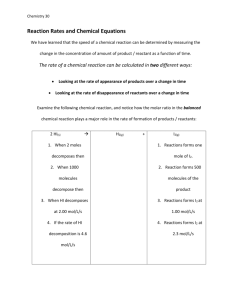
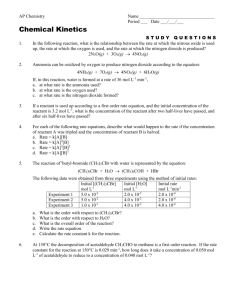
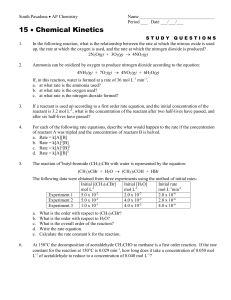


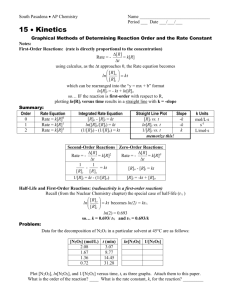

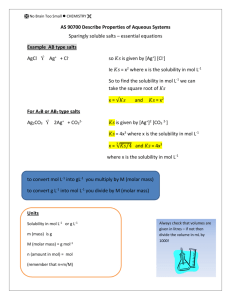
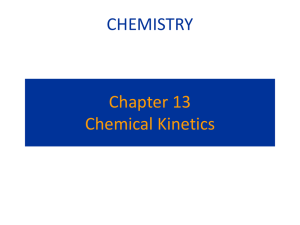

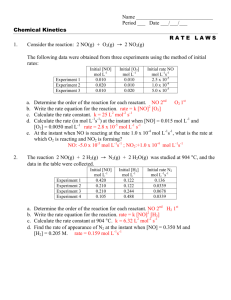
![Some Examples of Experimental Rate Laws Rate = k[A]](http://s3.studylib.net/store/data/008429765_1-55c81f2e6368c61bd42b7e157f3d34f1-300x300.png)